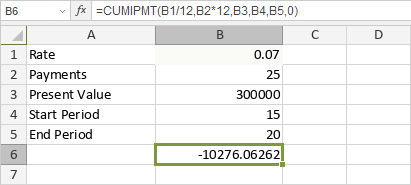CUMIPMT Function
The CUMIPMT function is one of the financial functions. It is used to calculate the cumulative interest paid on an investment between two periods based on a specified interest rate and a constant payment schedule.
The CUMIPMT function syntax is:
CUMIPMT(rate, nper, pv, start_period, end_period, type)
where
rate is the interest rate for the investment.
nper is a number of payments.
pv is a present value of the payments.
start_period is the first period included into the calculation. The value must be from 1 to nper.
end_period is the last period included into the calculation. The value must be from 1 to nper.
type is a period when the payments are due. If it is set to 0 or omitted, the function will assume the payments to be due at the end of the period. If type is set to 1, the payments are due at the beginning of the period.
Note: cash paid out (such as deposits to savings) is represented by negative numbers; cash received (such as dividend checks) is represented by positive numbers. Units for rate and nper must be consistent: use N%/12 for rate and N*12 for nper in case of monthly payments, N%/4 for rate and N*4 for nper in case of quarterly payments, N% for rate and N for nper in case of annual payments.
The numeric values can be entered manually or included into the cell you make reference to.
To apply the CUMIPMT function,
- select the cell where you wish to display the result,
- click the Insert Function
 icon situated at the top toolbar,
icon situated at the top toolbar,
or right-click within a selected cell and select the Insert Function option from the menu,
or click the icon situated at the formula bar,
icon situated at the formula bar,
- select the Financial function group from the list,
- click the CUMIPMT function,
- enter the required arguments separating them by commas,
- press the Enter button.
The result will be displayed in the selected cell.
